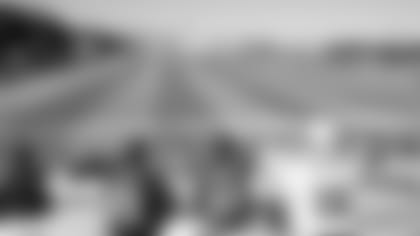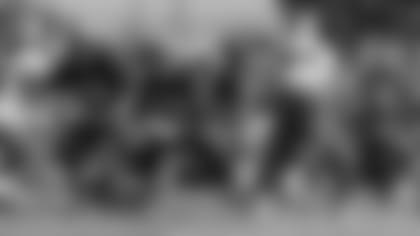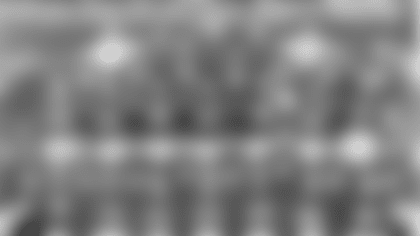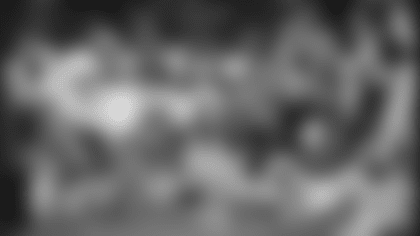University of the Pacific, 1998-2002
Stockton, CA
After posting a 13-3 record in 1997 and advancing to the NFC Championship Game, the 49ers moved to a new training camp facility at University of the Pacific with high hopes for the season.
In mid-July, all rookies reported to camp along with a few vets eager to get an early jump on the training sessions. Among them were wide receiver Jerry Rice and offensive tackle Harris Barton. Both men were trying to rebound from injuries that sidelined them for most of the 1997 campaign.
On the evening of July 20, 1998, a mandatory meeting for all rookies and veterans was scheduled for 5 pm. At 4:59 quarterback Steve Young, the last person to arrive, strolled through the meeting room door announcing the season had begun. With the exception of top draft pick R.W. McQuarters, who was working out contract details with the club, all players were present for the team's initial get together.
Little did they know a startling revelation would soon unfold.
Meanwhile, the team meeting proceeded and 49ers vice president Dwight Clark and second-year head coach Steve Mariucci welcomed players to the Stockton facility.
Mariucci responded to the inevitable changes veterans would experience with a new training camp credo, "No Whining," after a few issues were vocalized during the opening days. Among the complaints he heard were: "there's too many people and not enough space in the locker room," "the showers don't have soap" and "there's only two toilets for 90 people."
Mariucci claimed that at the end of camp the player uttering the most complaints would receive a commemorative T-Shirt reading "I'm a Whiner."
Since the 49ers were new to the area, local law enforcement personnel joined the team meeting to provide safety tips. Most importantly, the Stockton Police Department and California Highway Patrol warned players of troublesome bars and areas to avoid at night.
By 11 pm that evening, the players were settling into their dormitory rooms when they heard knocks at their doors. Some were already asleep while others ignored the commotion.
Then in a hurriedly organized meeting, Clark dropped the bombshell. Carmen Policy, the 49ers president and CEO since 1991, was resigning.
The following day was mildly chaotic. Media descended on the UOP campus searching for answers. Clark and Mariucci held press conferences then realized they had as many questions about the sudden change as the reporters.
For the most part the players were unfazed. The next day they dressed out in full pads for the first time and went to work.
"Nobody really got much done that day," Clark said. "There were a lot of distractions."
Within a week, the 49ers returned to semi-normal business. "We've got a football season to get ready for," Mariucci said.
By late July, the 49ers front office commotion had settled and the club held its first Fan Fest in Stockton. Attendees were clearly delighted to be treated to autographs from active players and 49ers alumni, along with a team scrimmage. Two weeks later, the city of Stockton returned the hospitality.
The 49ers were finishing their third week and 36th practice in Stockton when the club held a scrimmage under the lights at UOP's Amos Alonzo Stagg Memorial Stadium against the San Diego Chargers. It turned out to be a premier standing-room only community event. Nearly 30,000 joyous fans paid $10 to see the football show.
49ers equipment manager Kevin Lartigue kicked off the festivities by singing a rousing rendition of the National Anthem. Then a pair of Cessna planes (not to be confused with Blue Angels) flew in unison over the stadium prompting one veteran staff member to wonder if former 49ers tight end Russ Francis would be parachuting onto the field.
Two surprise guests were on hand to see the scrimmage, former 49ers head coach George Seifert, and Policy, who resigned just two weeks earlier and would eventually return to the NFL as CEO and president of the Cleveland Browns.
Policy was instrumental in moving training camp to UOP and was pleasantly surprised by the fan turnout.
"Everywhere I went people talked about how they loved the 49ers here and how much it meant to the community," he said.
Several members of the 49ers staff agreed with Policy's assessment.
"One thing we developed was a rapport and a relationship with the city of Stockton and the University of the Pacific," Mariucci said. "Everybody here is bending over backward to make it work. The hospitality here has been second to none."
Since food is on the mind of nearly every player, several linemen were thrilled by the quality and variety of Stockton's restaurants.
"It's a bigger city here. Guys have been enjoying the different restaurants," Barton said. "In Rocklin there's not a lot."
The scrimmage itself was anticlimactic. Rice sat it out but spoke glowingly of UOP's well-groomed practice fields. Young played sparingly before turning the offense over to Jim Druckenmiller. The offensive line concentrated on getting its timing down while executing running plays. Still, that did not damper the enthusiasm of the Stockton crowd. They were happy to have a five-time Super Bowl champion club to call their own, if only for the summer.
On the second day of August in 1998, San Francisco played its first exhibition game against the New England Patriots at Candlestick Park. Druckenmiller looked sharp and appeared ready to make a run at the starting QB job. He connected on 10-of-14 passes for 100 yards in a 14-13 victory.
Although Rice continued to work himself into shape, he sat out the game and predicted he would be in the lineup on opening day.
"It's a fresh start for me," Rice said. "With everything that happened to me last year. I feel like a rookie all over again."
He responded with 82 catches for 1,157 yards that season and was selected to his 12th Pro Bowl.
In 2002, the 49ers began the 57th training camp in club history, and their last at UOP, with their eyes on the playoffs.
In five years of summer training in Stockton, a steady stream of loyal fans, averaging over 1,300 per day, flocked to the practice field. During that time, the 49ers became part of the Stockton family. Fans were allowed to get close to the action, make eye contact with their favorite players, and hear the grunts and groans at individual drills from less than five yards away.
Mariucci, in his sixth season at the helm, and general manager Terry Donahue, starting his second season in San Francisco, expressed confidence in their roster. Quarterback Jeff Garcia and receiver Terrell Owens, fresh off Pro Bowl seasons, were ready to ignite the passing game. Running back Garrison Hearst was back on the field and regained the speed and explosiveness he exhibited prior to sustaining a near career-ending leg injury that took two years to rehab. Hearst returned to action in 2001, gained 1,206 yards rushing and earned NFL Comeback Player of the Year honors.
After just eight days of a 26-day training camp, the 49ers were scheduled to hop on a plane to Osaka, Japan for their first exhibition game, a matchup against Washington as part of the American Bowl series. Coaches saw a silver lining. Because of the early season matchup, veterans, who usually report a week after the rookies, were required to arrive at camp on the same day as the newcomers. The club would begin two-a-day sessions immediately. It marked the first time in memory the entire team practiced together from the start of training camp to the finish.
The game itself was a glorified scrimmage. Washington, coached by former 49ers quarterback Steve Spurrier, rolled over San Francisco 38-7. The 49ers only score came on a nine-yard run by running back Kevan Barlow.
The game had significant meaning from a cultural standpoint. The 49ers franchise, and the energetic crowd at Japan's Osaka Dome, recognized a significant milestone in football history by honoring former 49ers running back and defensive back Wally Yonamine, the first player of Japanese descent to play pro football. Yonamine started in three of the 49ers 12 All-America Football Conference games in 1947, and then left football for a baseball career. In an amazing turn of events, he became a legend in the Japanese Baseball League, earning seven All-Star berths and a place in the Japanese Baseball Hall of Fame.
The 77-year-old Yonamine was treated like royalty in the days before the contest attending 49ers practices as a guest of Coach Mariucci. On game day, he was presented with a 49ers jersey labeled "Yonamine" and was recognized during an on-field ceremony as the first player of Japanese descent to play pro football. After serving as the 49ers honorary team captain, he retreated to the owner's box to view the game where he also received a highlight tape of his playing days in San Francisco.
"It was an honor to be the first player of Japanese descent in the league," Yonamine said that day. "I hope that other players from Japan can reach the same level."
As for the 49ers players, they were exhausted by the overseas excursion. With flight time, jet lag, sightseeing and public relations events, it turned into a five-day trip for just 60 minutes of football.
"We've got to make the best of it," Mariucci said.
SAP Performance Facility, 2003-Present
Santa Clara, CA
The 49ers said goodbye to Stockton's UOP training facility after the 2002 season. General Manager Terry Donahue, and the 49ers brass, made a collective decision to use the club's Santa Clara headquarters for training camp beginning in 2003.
Players would miss interacting with fans at intimate college settings like Rocklin and Stockton, but practicing at 4949 Centennial Way (now 4949 Marie P. DeBartolo Way) offered unique advantages. Rather than transporting truckloads of gear hundreds of miles and spending weeks at remote locations, the 49ers were in familiar territory. They could now practice on three football fields, lift weights in their own spacious facility, and hold team drills in cooler temperatures.
"Practicing in the heat was overrated," Donahue said. "Years ago coaches thought it was a good way to lose a little weight and get in shape. But now everyone arrives in shape and there is much more awareness of heat exhaustion and the need to stay hydrated."
Coaches also felt they could accomplish more at their home facility. They had immediate access to their own offices and the club's film room, which allowed them to review the day's practice after it ended.
New players were housed at a comfortable nearby hotel rather than a stuffy college dorm. Veterans could return home each evening to sleep in their own bed.
Most practices, with a few exceptions, were generally closed to the public. Children from summer camps and local school field trips occasionally popped in for a visit. The club organized two scrimmages that would be open to the public: one at nearby San Jose State and the other at San Francisco's Kezar Stadium.
First-year head coach Dennis Erickson had barely finished his opening week of practice when he realized he had a musical protégé in his midst. QB Jeff Garcia was seen filming a possible spot in an upcoming video with Vallejo rapper E-40 titled "Quarterbackin'." Terrell Owens, Garrison Hearst, Fred Beasley, Kevan Barlow and Derrick Deese joined in with a dance sequence in front of the goal posts but Garcia was the headliner and busted out a funky version of the chicken dance.
In conversations with the media, Erickson vowed to open up the 49ers offense and throw downfield more often. That strategy was evident in the first few practice sessions. Erickson also implemented a two-minute offense, which he felt would be effective at unexpected times in a game rather than at the end of a half. With a nimble QB like Garcia at the helm. it would be an effective change of pace.
"We might use it for one series to slow down blitzes and wear out the defense," Erickson said.
After the early closed practices, Garcia noted the quiet sideline and lack of fans seemed to lower the on-field energy level.
"When you have fans in the stands it motivates you to pick up the tempo. You don't want to embarrass yourself in front of them," said Garcia who attended San Jose State and owned a home in San Jose.
In the second week of practice, Garcia led the 49ers to his alma mater to play in front of 8,000 fans admitted free of charge to Spartan Stadium for the club's first scrimmage. He was clearly in his element. Garcia was the last player introduced and jogged onto the field in a blue San Jose State cap while firing T-shirts to the adoring crowd.
"For me, there's a lot of pride in coming back here," said Garcia, who was inducted into the San Jose State Sports Hall of Fame two months later. "It was one of those days when you wish practice lasted a little longer."
During the 90-minute event, fans saw Frisbee-catching dogs and heard a rock & roll band before watching a lively passing game that included a 42-yard scoring pass from Garcia to Owens. Receiver Tai Streets also nabbed a TD pass and Garrison Hearst showed off his gritty toughness on a short run to the end zone.

Still, the day clearly belonged to Garcia. Several players noted the uptick in energy after eight days of quiet and low-key practices at the 49ers facility.
"I like having fans around," tackle Derrick Deese said. "They appreciate the effort and that gives you a little more incentive."
Owens, who sat out the morning practice with muscle soreness, felt enough spark from the exuberant crowd to join the afternoon scrimmage.
"Working out in Santa Clara is just practice," Owens said. "The scrimmage was more like a game. Once you see fans in the stands you want to put on a show."
In early August, the 49ers took on the Raiders in their Battle of the Bay exhibition game. Garcia rested his ailing back, allowing a trio of backup QBs, Ken Dorsey, Tim Rattay and Brandon Doman, to handle the signal-calling duties. Doman tossed a 10-yard scoring pass to WR Cedrick Wilson in the second quarter. Dorsey, the former University of Miami star who guided the Hurricanes to a National Championship, fired a nine-yard game-winning TD pass to fullback Matt Stanley with 2:19 remaining in the 49ers 14-10 win.
Before the regular season began, the 49ers held a final tune-up practice at San Francisco's Kezar Stadium. Nearly 9,000 of the 49ers Faithful filed in, wearing red and gold jackets and the jerseys of their favorite players, from Brodie and Montana to Garcia and Rice.
Several former 49ers were on hand signing autographs and swapping stories including Y.A. Tittle, R.C. Owens, Bob St. Clair, Joe Perry and J.D. Smith. All five spent a major part of their NFL careers at Kezar Stadium.
"It's great to see the team has a sense of its history," St. Clair said. "You can tell the ownership and the front office have an appreciation for the guys who went before these players."
St. Clair's career trumped them all. The Pro Football Hall of Fame tackle played 189 football games at Kezar Stadium, starting with Polytechnic High School located directly across the street from Kezar, through his college days at USF and finally with the 49ers. In 2001, the city of San Francisco named the Kezar Stadium playing surface Bob St. Clair Field after its native son.
"So many memories, so many good times," St. Clair said. "I hope the 49ers are back here many times in the future."
Several players and coaches were happily surprised at the reception they received at the 49ers original home field from 1946-1970. They were introduced one-by-one and raced on the field through a corridor of team cheerleaders. Coach Erickson then led the club through a light 90-minute non-contact workout in shorts and helmets.
"It's great to come back to where it started," Erickson said. "It's pretty unique. When you go back to 1946, there's a lot of years in between. This franchise is pretty special because of that tradition."
The 2007 NFL Draft brought two first round picks to San Francisco, linebacker Patrick Willis (11th selection) and tight end-turned-offensive tackle Joe Staley (28th selection). When training camp rolled around that summer, 247Sports contributor Craig Massai offered his insight on the two collegiate standouts.
"The team's speedy, athletic first-round draft pick has 'impact' written all over him," he wrote of Willis in his "Key New Faces" article, written at the onset of the 2007 49ers training camp. "This youngster possesses Defensive Rookie of the Year-type talent and that kind of future with the team."
Massai was right on the nose with his evaluation of the inside linebacker. Not only did Willis earn Defensive Rookie of the Year honors for the 2007 season, he went on to become one of the greatest linebackers in 49ers history during his eight seasons in San Francisco. He earned seven consecutive Pro Bowl selections, was named First-Team, All-Pro six times, and helped get the Niners into the playoffs for three consecutive seasons. To honor his accomplishments and contributions to the franchise, Willis will be inducted into the 49ers Hall of Fame in 2021.
Of Staley, Massai writes that he "will be the future at one of the team's offensive tackle positions." Staley was relatively new to the offensive line, having started his collegiate career as a tight end for Central Michigan. Because of his large stature, Staley was moved to left tackle his sophomore season and made a name for himself as a stalwart-yet-speedy blocker.
"Given his relative inexperience at the position, Staley faces a learning curve at the pro level. But it already began this spring, and it appears he has the talent and natural ability to justify the team's draft-day maneuvering to get him," Massai mused in his training camp preview.
Trading up for an additional first round pick that year was certainly justified. Staley's 13-season playing career included six Pro Bowl selections, two Super Bowl appearances, a bobble head figure with his likeness, and a reputation for being a spirited leader amongst his teammates, both on the field and in the locker room.
Though retired, Staley still shows his support for the franchise where he spent his entire career. He was recently spotted on the sidelines of the 49ers joint practice with the Los Angeles Chargers in August 2021.
In 2011, NFL training camps were delayed due to a labor dispute and player lockout. New 49ers head coach Jim Harbaugh looked to veteran quarterback Alex Smith for assistance.
The work stoppage began in March but during the lockout, Smith led drills for the 49ers, organizing practice sessions and installing the basics of Harbaugh's offense. Ironically, Smith was an unrestricted free agent at the time and not technically a 49ers quarterback. About two dozen offensive players attended Smith's informal workouts, dubbed "Camp Alex."
The lockout ended in late July and linebacker Patrick Willis was one of the first players through the door at 4949 Centennial Way. He found the locker room decorated with posters sporting Harbaugh's favorite sayings. Among them - "You Are Getting Better or Getting Worse, You never stay the same," and "Yourself, family and team."
One of Harbaugh's first orders of business was to meet his offensive linemen—Joe Staley, Adam Snyder, Anthony Davis and Mike Iupati. Harbaugh realized the running game, with Frank Gore as the workhorse, would be the heart of his offense.
"It's important that those guys play well together," Harbaugh said. "I think they got the right makeup to do that."

The 49ers held Fan Fest for the first time in nearly 20 years in mid-August. As over 8,000 Faithful filed into Candlestick Park to see an afternoon practice, they noticed The 'Stick's reconfigured entrance gate. Just inside was a display celebrating 49ers history. It housed plaques representing the club's Hall of Famers, its five Super Bowl trophies, Super Bowl rings and a non-stop film showing Super Bowl XVI, the club's first NFL championship. This space was the predecessor of the 49ers Museum presented by Foxconn Industrial Internet, a 20,000 square foot venue that opened inside of Levi's® Stadium in 2014.
Once inside Candlestick, fans were able to watch individual drills on the field then see the club's offense go through a series of passing and running plays. After a light scrimmage, the players were available to sign autographs.
Among the players who saw extensive action at the scrimmage was second-round draft pick Colin Kaepernick. Harbaugh was eager to see his rookie quarterback push Smith for the starting QB spot.
Harbaugh also considered signing veteran QB Daunte Culpepper who played 11 NFL seasons, mostly in Minnesota, before retiring in 2009. Culpepper appeared at the 49ers facility for a tryout but Harbaugh ultimately chose to stay with the men already on the roster. The player lockout may have influenced his decision. Harbaugh claimed his offensive playbook would generally take four months to install properly. Because of the labor dispute, the club had barely a month to learn it and Smith was the man most familiar with it after running "Camp Alex."
In the Battle of the Bay, Smith showed he had the upper hand. San Francisco beat the Oakland Raiders 17-3 and Smith displayed a good grasp of the offense. He completed eight of 13 passes for 126 yards, including a beautifully placed 32-yard toss to receiver Braylon Edwards near the sideline.
As the 2011 season progressed, Smith proved he was the right man for the job. He helped resurrect the franchise leading the 49ers to a 13-3 record and the NFC Championship Game.
In the decade since that heart-breaking loss to the New York Giants at the 2011 NFC title game, the 49ers have built a state-of-the-art facility at Levi's® Stadium, played in two Super Bowls and survived a pandemic-stricken season without fans in the stands.
Now, with Coach Kyle Shanahan at the helm, the club prepares to celebrate its 75th anniversary in 2021. Kicking off another training camp at its Santa Clara headquarters on July 28, the franchise welcomed the 49ers Faithful back to Levi's® Stadium with an open practice on the team's home field on August 7. The event was also celebrated as "8/7 Day" the 49ers annual celebration of Dwight Clark (who wore #87 for the 49ers) and those affected by ALS. This was the first fan event in the stadium since the 2019 NFC Championship Game was held in Santa Clara on January 19, 2020.














